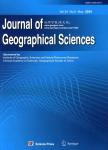Dynamic evolution and the mechanism of modern gully agriculture regional function in the Loess Plateau
Dynamic evolution and the mechanism of modern gully agriculture regional function in the Loess Plateau作者机构:School of Public Policy and AdministrationChongqing UniversityChongqing 400044China Institute of Geographic Sciences and Natural Resources ResearchCASBeijing 100101China Key Laboratory of Regional Sustainable Development ModelingCASBeijing 100101China School of Geography and PlanningNingxia UniversityYinchuan 750021China
出 版 物:《Journal of Geographical Sciences》 (地理学报(英文版))
年 卷 期:2022年第32卷第11期
页 面:2229-2250页
核心收录:
学科分类:060201[历史学-历史地理学] 02[经济学] 0202[经济学-应用经济学] 06[历史学] 020202[经济学-区域经济学] 0705[理学-地理学] 0602[历史学-中国史]
基 金:National Natural Science Foundation of China,No.42101202,No.42061037 National Natural Science Foundation of China and National Science Foundation of the United States Sustainable Regional System Cooperation Research Project,No.T221101034 China Postdoctoral Science,No.2022M710015 Fundamental Research Funds for the Central Universities,No.2022CDJSKJC29。
主 题:dynamic mechanism functional evolution gully human-earth system Loess Plateau modern gully agriculture transformation and development
摘 要:The agricultural regional type and function are the key theoretical issues in agricultural geography research.Gully agriculture in the Loess Plateau is a new regional type of agricultural system with the coupling development of the modern gully human-earth relationship.The study of its functional changes is of great practical significance for food security,rural revitalization and sustainable development of regional agriculture in the region of interest.This paper analyses the multifunctional change of gully agriculture in the Loess Plateau and its dynamic mechanism by using large-scale remote sensing data,topographic relief amplitude model,and spatial econometric model to understand internal implications for evolution differentiation at the basin level.The results show that:(1)The spatial concentration of production and supply function of agricultural products(APF)in the gully of the Loess Plateau gully is high,while the ecological conservation and maintenance function(ECF),employment and social security function(ESF),cultural heritage and leisure function(CRF)are relatively low.The four functions’spatial distribution has revealed an apparent regularity.(2)APF has been significantly enhanced,which is mainly distributed in point clusters and strips in the farming and pastoral areas in northern Shaanxi to the Yanhe river basin.The high-value areas of ESF are clustered around the urbanized metropolitan circles and urban-rural staggered areas along the Great Wall.ECF is concentrated in areas with significant natural endowments and excellent ecological conditions.CRF is significantly higher in the municipal districts and the surrounding regional central cities.(3)There are noticeable differences in the gully agriculture regional function(GARF)evolution process due to the geographical environment and socio-economic development stages.In this regard,natural factors have tremendously affected APF,ESF,and ECF,while socio-economic factors greatly differ in the four functions.There are still differences in the driving mechanisms of modern gully agriculture evolution types;hence many critical policies in the Loess Plateau can directly affect the function evolution paths.The dynamic evolution of GARF can reflect the general law of rural human-earth system transition in gully areas,thereby providing policy ideas for high-quality development of agriculture in the Loess Plateau.



